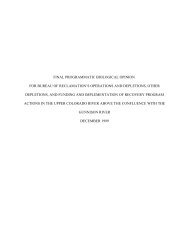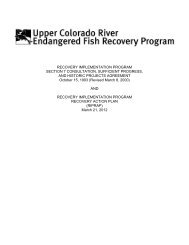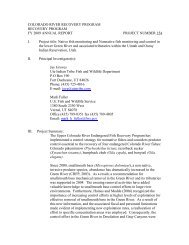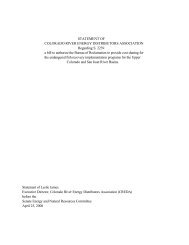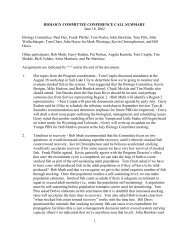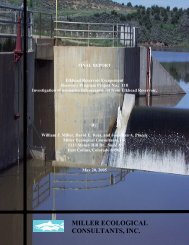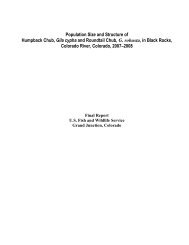K. R. Bestgen, K. A. Zelasko, and G. C. White. Monitoring ...
K. R. Bestgen, K. A. Zelasko, and G. C. White. Monitoring ...
K. R. Bestgen, K. A. Zelasko, and G. C. White. Monitoring ...
Create successful ePaper yourself
Turn your PDF publications into a flip-book with our unique Google optimized e-Paper software.
<strong>and</strong> absence of any fish stocked in 2007. Mixed patterns were also evident in the middle Green<br />
River, as abundance in 2006 <strong>and</strong> stocking numbers in 2005 were lowest, <strong>and</strong> abundance<br />
increased in 2007 consistent with higher stocking numbers in 2006. However, abundance<br />
declined in 2008 by about 65%, even though stocking numbers were highest in 2007.<br />
The large swings in abundance of razorback suckers among years would not be expected<br />
in a stable population of wild fish. Even relatively small populations of wild razorback suckers<br />
in the middle Green River in the 1980’s <strong>and</strong> early 1990’s did not experience dramatic population<br />
swings, likely because of lack of recruitment <strong>and</strong> because the population was influenced mainly<br />
by mortality of aging fish. One explanation for large population swings is the low survival rates<br />
of fish just post-stocking, as amply demonstrated by <strong>Zelasko</strong> et al. (2010; 2011). Survival rates<br />
must have been very low in the 2007–2008 interval for population abundances to decline so<br />
dramatically in each reach. That relatively low flow year in 2007 may have had an adverse<br />
influence on survival rates; <strong>Bestgen</strong> et al. (2010) did not estimate annual survival rates for<br />
Colorado pikeminnow in the 2006–2008 period so no comparisons are possible. Another likely<br />
explanation for apparently large swings in abundance among years is that high abundances in<br />
2007 may have been biased by very low recapture rates; capture rates biased low would have the<br />
effect of increasing population abundance because numbers of fish captured divided by an<br />
unrepresentative <strong>and</strong> low p would increase apparent abundance. It is important to remember that<br />
the abundance estimates presented here are for all life stages present; razorback sucker adults (><br />
400 mm TL) represented only 37% of fish captured in the 2006–2008 period so adult abundance<br />
is substantially lower than the estimates portray.<br />
Colorado River data, fish distribution, <strong>and</strong> macrohabitat use. —The 2005 sampling for<br />
Colorado pikeminnow abundance estimation in the Colorado River also resulted in capture of<br />
relatively large numbers of razorback suckers (Osmundson <strong>and</strong> Seal 2009). Distribution of<br />
larger juvenile <strong>and</strong> adult razorback suckers in 2005 in the Colorado River was more concentrated<br />
upstream, where about 60% of those fish were from the Palisade-to-Westwater reach<br />
(Osmundson <strong>and</strong> Seal 2009, Figure 10). About 40% of razorback sucker captures were from the<br />
more downstream reach Cottonwood Wash to the Green River confluence but < 1% of razorback<br />
suckers were captured in the lowermost 46 miles from Potash to the Green River confluence.<br />
Low abundance of razorback suckers was also noted in Westwater Canyon (e.g., RM 125–120,<br />
in part) <strong>and</strong> in the most upstream 5-mile reach just below Price-Stubb diversion.<br />
36



